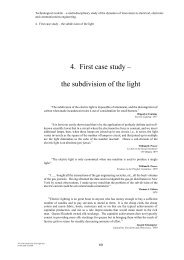Valuation Techniques for Social Cost-Benefit Analysis: - HM Treasury
Valuation Techniques for Social Cost-Benefit Analysis: - HM Treasury
Valuation Techniques for Social Cost-Benefit Analysis: - HM Treasury
Create successful ePaper yourself
Turn your PDF publications into a flip-book with our unique Google optimized e-Paper software.
38<br />
As already discussed in section 4.2.4 part of the reason <strong>for</strong> the high valuations is likely to be that<br />
income is often not instrumented. Using an instrumental variable <strong>for</strong> income tends to increase<br />
the income coefficient, thus reducing the income compensation values.<br />
Relative income<br />
There is a theoretical justification <strong>for</strong> the inclusion of relative income in the utility function to<br />
account <strong>for</strong> reference group effects (Duesenberry, 1949; Frank, 1997). There is empirical<br />
evidence that relativities in income matter to well-being (Blanchflower and Oswald, 2004;<br />
Easterlin, 1974; Easterlin, 1995, 2001a; Ferrer-i-Carbonell, 2005; Graham and Felton, 2006;<br />
Luttmer, 2005; McBride, 2001). Relative income effects can be controlled <strong>for</strong> by including a<br />
measure of the average income <strong>for</strong> the reference group as an additional explanatory variable.<br />
Controlling <strong>for</strong> relative income in the LS function tends to have the effect of increasing the<br />
impact (ie, coefficient) of income on LS (eg, Alpizar et al., 2005; Clark et al., 2008; Easterlin,<br />
1995; Frank, 2005). This is because in essence the ‗price‘ of status is held constant as other<br />
people‘s incomes do not change.<br />
There is no consensus on whether relative income should be included when estimating income<br />
compensations. In theory Stated Preference techniques implicitly hold others‘ income constant<br />
as people are asked to think about their own finances only. This could be seen as an argument<br />
<strong>for</strong> including relative income in the LS function and this is likely to reduce the levels of income<br />
compensation required <strong>for</strong> non-market goods. However, including relative income in the LS<br />
function is not an easy task as assumptions need to be made in the empirical analysis as to what<br />
group is used as the reference group (Pischke, 2010). For example is the appropriate reference<br />
the incomes of work colleagues, wage levels in the region or GDP per capita? The effect on the<br />
income coefficient will vary depending on the reference group used (Dolan and Peasgood,<br />
2006).<br />
Indirect effects of income<br />
As well as affecting our utility directly (<strong>for</strong> example, the pleasure of having more money in the<br />
bank), income affects utility indirectly through the goods and services it allows individuals to<br />
purchase (Dolan et al., 2011b; Dolan and Peasgood, 2006). Income may have a positive effect<br />
on a number of variables that are held constant in the life satisfaction regression, such as health,<br />
social relationships, marital status and place of residence. Controlling <strong>for</strong> these effects there<strong>for</strong>e<br />
subdues the impact of income on well-being and inflates the monetary values derived (Dolan et<br />
al., 2011b). In Stated Preference surveys people are often urged to think about the value of<br />
money when stating a WTP figure. In other words, they should consider the opportunity costs or<br />
everything else they could do with the money, and so in line with the above argument, in<br />
theory, people are asked to think about how income impacts on their health, relationships and<br />
place of residence.<br />
The indirect effects of income have generally been ignored by the LS approach literature. One<br />
exception is Ferrer-i-Carbonell and van Praag (2002), who model the impacts of income on life<br />
satisfaction through its effects on a set of domain satisfactions, including leisure, housing and<br />
job satisfaction. A problem with this approach is that the final LS function does not include<br />
controls <strong>for</strong> many of the explanatory variables that have been shown to impact on SWB, such as<br />
age and marital status, thus biasing the model. We discuss some solutions to this problem<br />
below.<br />
Counter-effects of income<br />
When calculating EV or CV we essentially consider exogenous changes in income required to<br />
hold utility constant. For example, if we are interested in estimating the level of compensation<br />
that would be required to return people to their original levels of utility after the loss of a good<br />
or service (ie, the compensating variation) this compensation is essentially an exogenous increase<br />
in income <strong>for</strong> those affected. However, the income variable used in the life satisfaction function<br />
is usually a measure of household income, which is in large part derived from labour income.





![AIRTO [Professor Dr Brian Blunden] - HM Treasury](https://img.yumpu.com/15492848/1/184x260/airto-professor-dr-brian-blunden-hm-treasury.jpg?quality=85)










